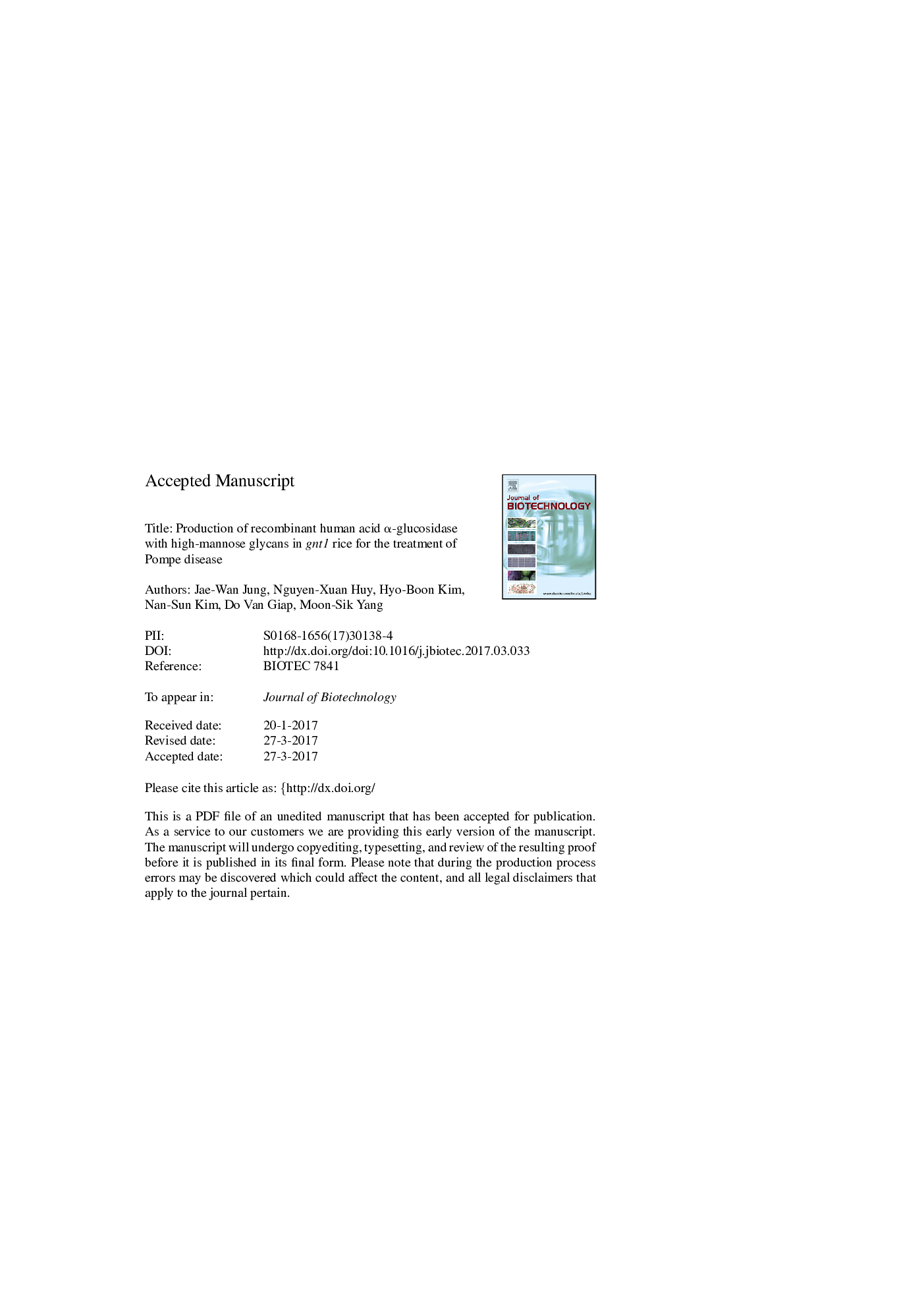| کد مقاله | کد نشریه | سال انتشار | مقاله انگلیسی | نسخه تمام متن |
|---|---|---|---|---|
| 4753670 | 1416995 | 2017 | 35 صفحه PDF | دانلود رایگان |
عنوان انگلیسی مقاله ISI
Production of recombinant human acid α-glucosidase with high-mannose glycans in gnt1 rice for the treatment of Pompe disease
دانلود مقاله + سفارش ترجمه
دانلود مقاله ISI انگلیسی
رایگان برای ایرانیان
کلمات کلیدی
موضوعات مرتبط
مهندسی و علوم پایه
مهندسی شیمی
بیو مهندسی (مهندسی زیستی)
پیش نمایش صفحه اول مقاله

چکیده انگلیسی
Lysosomal storage diseases are a group of inherited metabolic disorders. Patients are treated with enzyme replacement therapy (ERT), in which the replacement enzymes are required to carry terminal mannose or mannose 6-phosphate residues to allow efficient uptake into target cells and tissues. N-acetylglucosaminyltransferase-I (GnTI) mediates N-glycosylation in the cis cisternae of the Golgi apparatus by adding N-acetylglucosamine to the exposed terminal mannose residue of core N-glycan structures for further processing. Mutant rice lacking GnTI produces only high mannosylated glycoproteins. In this study, we introduced a gene encoding recombinant human acid α-glucosidase (rhGAA), which is used in ERT for Pompe disease, into gnt1 rice callus by particle bombardment. Integration of the target gene into the genome of the gnt1 rice line and its mRNA expression were confirmed by PCR and Northern blot, respectively. Western blot analysis was performed to confirm secretion of the target proteins into the culture media. Using an indirect enzyme linked immunosorbent assay, we determined the maximum expression of rhGAA to be approximately 45 mg/L, 13 days after induction. To assay the enzymatic activity and determine the N-glycan profile of rhGAA, we purified the protein using a 6 Ã histidine tag. The in vitro α-glucosidase activity of rhGAA from gnt1 rice callus (gnt1-GAA) was 3.092 U/mg, similar to the activity of the Chinese hamster ovary cell-derived GAA (3.154 U/mg). N-glycan analysis revealed the presence of high-mannose N-glycans on gnt1-GAA. In addition, the production of high-mannose GAA using gnt1 rice calli as an expression host was characterized, which may aid the future development of therapeutic enzymes for the treatment of Pompe disease.
ناشر
Database: Elsevier - ScienceDirect (ساینس دایرکت)
Journal: Journal of Biotechnology - Volume 249, 10 May 2017, Pages 42-50
Journal: Journal of Biotechnology - Volume 249, 10 May 2017, Pages 42-50
نویسندگان
Jae-Wan Jung, Nguyen-Xuan Huy, Hyo-Boon Kim, Nan-Sun Kim, Do Van Giap, Moon-Sik Yang,